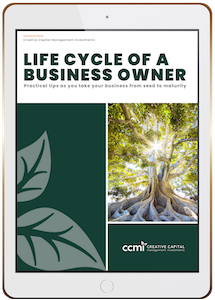If you’ve started a new job, your company may have offered you an employer-sponsored 401(k), a low-stress savings vehicle that’s familiar to many professionals. What’s not so well-known when establishing a 401(k) plan for the first time or switching careers is that, when overlooked, you could adversely affect your long-term savings if you miss a few key steps. Here are four questions you should ask when you’re setting up your plan to ensure you’re using the retirement benefit to its full potential.
“How Much Should I Contribute?”
The amount you decide to contribute to your 401(k) will be personal to your goals and financial situation. Still, it’s helpful to consider the benefits of maximizing your contributions. For example, contributing as much as you can early on puts time and compounding on your side. Plus, your contributions are pre-tax, which lowers your taxable income, offering a tax break in the current year.
We often recommend our clients contribute as much as they can afford according to the IRS’ annual contribution limits, which for 2021 are $19,500 for those under 50 and $26,000 for those over 50.
If your employer offers a 401(k) matching program, you may also consider, at the very least, contributing up to the matching amount. Suppose your company matches up to 5% of your salary. In this case, be sure to contribute at least 5% of your salary to your 401(k) to take advantage of those extra dollars – it’s free money!.
“What Are My Default Investment Options?”
Your 401(k) may have rules that require default investment fund selections for every new enrollee. After you enroll, it is up to you to review those selections to ensure they align with your age, risk tolerance, and goals. We encourage you to look at your options or consult with a financial advisor to confirm your 401(k) is working for you.
- Review your default investment selections. Ensure you’re taking advantage of funds with lower fees and your portfolio is appropriately diversified based on your age and goals. Since every plan is different, we recommend working with a financial advisor who can help you during this process and offer customized allocation solutions.
- Determine if it’s an age-based retirement fund. An age-based fund will allocate your funds and risk based on your age and a general timeline of when you’ll retire. For example, if you’re further away from retirement, you may have more risk than if you’re preparing to retire in a few years. Most plans with this fund type will automatically rebalance your investments based on your age and projected retirement date.
- Some plans may default to a stable value or money market fund, which has very little growth potential but is not likely to lose value. If you are a long term investor, you’ll want to change your investment election to something that has the potential to grow your wealth over time.. We suggest working with an advisor if you’re interested in learning more about these types of funds and if they suit your situation.
“When Should I Rebalance My Plan?”
Rebalancing sets your allocations and risk to what you originally intended after experiencing market fluctuations. For example, your allocation may have shifted your risk exposure if a particular asset class did well and another performed more poorly than expected, which means your portfolio no longer resembles the original allocation you had intended to maintainRebalancing resets your portfolio to your initial targets, or perhaps to a new target.
We encourage you to log into your 401(k) account at least once a year to initiate the rebalancing process. Some plans may offer automatic rebalancing annually, but to make it easy, we suggest checking in on your birthday to confirm everything’s on track. An advisor can also help you with the process if you choose not to use the tools offered within your plan or need further guidance.
“Should I Choose a Traditional or Roth 401(k)?”
As we already mentioned, your plan may have preset defaults built into it as a new enrollee, including being enrolled in a traditional pre-tax 401(k). The traditional 401(k) is a commonly used plan where you contribute pre-tax income—earning a tax break in the current year—and pay taxes on your withdrawals, which are considered income in retirement.
However, if you’re a young professional in a lower tax bracket, you may consider the Roth 401(k) option if your company offers one. While you won’t get a tax break in the current year because you’ll make after-tax contributions, a Roth 401(k) does allow you to grow your savings and make withdrawals in retirement tax-free under current laws. You also have the option of deferring a portion of your contributions to one or both plans, if available.
There are tax advantages to the traditional and Roth options, so you should explore all the benefits available, possibly with an advisor, before making a selection.
How CCMI Can Help
A long-term savings approach for your life after your career begins with the actions you take today. A 401(k) is your opportunity to get started. Contact our team today and learn how we help young professionals and those nearing retirement plan for the future.
CCMI provides personalized fee-only financial planning and investment management services to business owners, professionals, individuals and families in San Diego and throughout the country. CCMI has a team of CERTIFIED FINANCIAL PLANNERTM professionals who act as fiduciaries, which means our clients’ interests always come first.
How can we help you?






